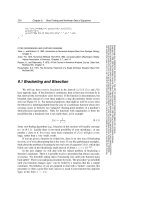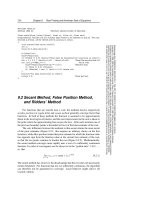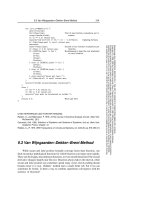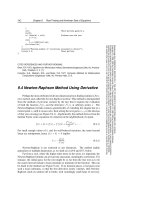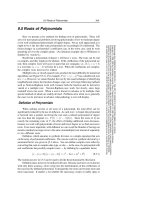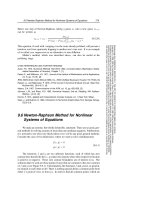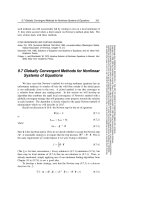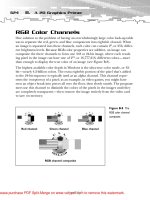Tài liệu Defining Needs and Managing Performance of Installation Support Contracts pptx
Bạn đang xem bản rút gọn của tài liệu. Xem và tải ngay bản đầy đủ của tài liệu tại đây (573.68 KB, 76 trang )
Prepared for the United States Air Force
Approved for public release, distribution unlimited
Perspectives from the Commercial Sector
Defining Needs and Managing
Performance of Installation
Support Contracts
R
|
PROJECT AIR FORCE
Laura H. Baldwin, Sarah Hunter
The RAND Corporation is a nonprofit research organization providing
objective analysis and effective solutions that address the challenges
facing the public and private sectors around the world. RAND’s
publications do not necessarily reflect the opinions of its research clients
and sponsors.
R
®
is a registered trademark.
© Copyright 2004 RAND Corporation
All rights reserved. No part of this book may be reproduced in any form
by any electronic or mechanical means (including photocopying,
recording, or information storage and retrieval) without permission in
writing from RAND.
Published 2004 by the RAND Corporation
1700 Main Street, P.O. Box 2138, Santa Monica, CA 90407-2138
1200 South Hayes Street, Arlington, VA 22202-5050
201 North Craig Street, Suite 202, Pittsburgh, PA 15213-1516
RAND URL: />To order RAND documents or to obtain additional information, contact
Distribution Services: Telephone: (310) 451-7002;
Fax: (310) 451-6915; Email:
Library of Congress Cataloging-in-Publication Data
Baldwin, Laura H., 1967-
Defining needs and managing performance of installation support contracts :
perspectives from the commercial sector / Laura H. Baldwin, Sarah Hunter.
p. cm.
Includes bibliographical references.
“MR-1812.”
ISBN 0-8330-3495-2 (pbk. : alk. paper)
1. Defense contracts—United States—Cost effectiveness. 2. United States. Air
Force—Facilities. I. Hunter, Sarah, 1968– II.Title.
UG1123.B33 2003
358.4'16212—dc22
2003023326
The research reported here was sponsored by the United States Air Force
under Contract F49642-01-C-0003. Further information may
be obtained from the Strategic Planning Division, Directorate of Plans,
Hq USAF.
iii
PREFACE
The Air Force is in the process of implementing performance-based
practices within its service contracts to improve service quality and
reduce costs. These practices include conveying to providers the Air
Force’s desired service outcomes, rather than how the service should
be performed; the use of measurable performance standards and
quality assurance surveillance plans to track performance against
clear goals; and the use of positive and negative incentives to align
provider efforts with Air Force needs. RAND Project AIR FORCE is
supporting these implementation efforts.
This report describes an analysis of best commercial practices for
purchasing facilities and food services that are analogous to services
the Air Force purchases to support its installations. We examine
whether and how commercial firms apply performance-based prac-
tices in these service contracts and draw out relevant and potentially
actionable “lessons learned” for the Air Force. This information
should be of interest to contracting officers, technical experts (e.g.,
civil engineers), and installation commanders who participate in
service acquisitions for installation services.
This research is a product of the study, “Supporting the Warfighter
Through Improved Service Contracts,” sponsored by the Deputy
Assistant Secretary for Contracting (SAF/AQC) and conducted within
the Resource Management Program of RAND Project AIR FORCE.
For almost a decade, the RAND Corporation has been helping the
Department of Defense improve the way it purchases goods and
services. Readers may also be interested in selected related studies:
iv Defining Needs and Managing Performance of Installation Support Contracts
• Implementing Performance-Based Services Acquisition (PBSA):
Perspectives from an Air Logistics Center and a Product Center,
John Ausink, Laura H. Baldwin, Sarah Hunter, and Chad Shirley,
RAND Corporation, DB-388-AF, 2002, which can be downloaded
from www.rand.org/publications/DB/DB388
• Implementing Best Purchasing and Supply Management Prac-
tices: Lessons from Innovative Commercial Firms, Nancy Y.
Moore, Laura H. Baldwin, Frank Camm, and Cynthia R. Cook,
RAND Corporation, DB-334-AF, 2002, which can be downloaded
from www.rand.org/publications/DB/DB334
• Federal Contract Bundling: A Framework for Making and
Justifying Decisions for Purchased Services, Laura H. Baldwin,
Frank Camm, and Nancy Y. Moore, RAND Corporation, MR-
1224-AF, 2001, which can be downloaded from www.rand.org/
publications/MR/MR1224
• Performance-Based Contracting in the Air Force: A Report on
Experiences in the Field, John Ausink, Frank Camm, and Charles
Cannon, RAND Corporation, DB-342-AF, 2001, which can be
downloaded from www.rand.org/publications/DB/DB342
• Strategic Sourcing: Measuring and Managing Performance, Laura
H. Baldwin, Frank Camm, and Nancy Y. Moore, RAND
Corporation, DB-287-AF, 2000, which can be downloaded from
www.rand.org/publications/DB/DB287
• Incentives to Undertake Sourcing Studies in the Air Force, Laura
H. Baldwin, Frank Camm, Edward G. Keating, and Ellen M. Pint,
RAND Corporation, DB-240-AF, 1998
• Strategic Sourcing: Theory and Evidence from Economics and
Business Management, Ellen M. Pint and Laura H. Baldwin,
RAND Corporation, MR-865-AF, 1997.
RAND PROJECT AIR FORCE
RAND Project AIR FORCE (PAF), a division of the RAND Corporation,
is the U.S. Air Force’s federally funded research and development
center for studies and analyses. PAF provides the Air Force with in-
dependent analyses of policy alternatives affecting the development,
employment, combat readiness, and support of current and future
Preface v
aerospace forces. Research is performed in four programs: Aero-
space Force Development; Manpower, Personnel, and Training;
Resource Management; and Strategy and Doctrine.
Additional information about PAF is available on our website at
/>
vii
CONTENTS
Preface iii
Tables ix
Summary xi
Acknowledgments xvii
Acronyms xix
Chapter One
RECENT POLICY EMPHASIS ON PERFORMANCE-BASED
SERVICES ACQUISITION (PBSA) 1
Outline of the Report 3
Chapter Two
GATHERING INFORMATION FROM LEADING
COMMERCIAL BUYERS AND PROVIDERS OF
FACILITIES AND FOOD SERVICES 5
Selection of Firms 5
Description of Interviewees 7
Interview Protocol 8
Chapter Three
RESEARCH FINDINGS ON SERVICES, CONTRACT
TYPES, AND THE USE OF PERFORMANCE-BASED
PRACTICES 11
Types of Services Discussed 11
Contract Pricing and Length 12
viii Defining Needs and Managing Performance of Installation Support Contracts
Use of Performance-Based Practices 14
Conveying Service Needs 14
Performance Management 17
Chapter Four
IMPLICATIONS FOR THE AIR FORCE 27
Air Force Experience to Date 27
Suggestions for the Future 29
Appendix
A. INTERVIEW PROTOCOLS 33
B. EXAMPLES OF PERFORMANCE METRICS 37
C. REPORTED USE OF PERFORMANCE-BASED
PRACTICES 43
References 55
ix
TABLES
2.1. Selection of Firms for the Study 7
2.2. General Descriptions of Interviewees 8
3.1. Types of Services Purchased or Provided 12
3.2. Contract Pricing and Length 14
xi
SUMMARY
In April 2000, Dr. Jack Gansler, Under Secretary of Defense for
Acquisition and Technology, established the goal that at least 50 per-
cent of all service acquisitions, measured in dollars and contracts,
should be performance-based by 2005. Air Force interest in perfor-
mance-based service contracts preceded Dr. Gansler’s memoran-
dum. On April 1, 1999, the Air Force issued Air Force Instruction
(AFI) 63-124, Performance-Based Service Contracts (PBSC), which
contains guidance on implementing performance-based practices
for purchasing a wide range of services to support its installations,
employees, and warfighting capability. Under what is now called
performance-based services acquisition (PBSA), buyers should
• describe what service is desired and not how to perform the
work,
• use measurable performance standards and quality assurance
plans,
• specify procedures for reductions in fee or price when services
do not meet contract requirements, and
• include performance incentives where appropriate.
1
Previous RAND research supports implementation of PBSA practices
in Air Force contracts for services associated with the development
and sustainment of weapon systems and installation activities
(Ausink et al., 2001 and 2002, and Baldwin et al., 2002). Building on
______________
1
Adapted from Federal Acquisition Regulation (FAR) Subpart 37.601.
xii Defining Needs and Managing Performance of Installation Support Contracts
this prior work, the Air Force (SAF/AQC) asked RAND to learn how
commercial buyers and providers of facilities services (including op-
erations and maintenance, custodial, groundskeeping, refuse and re-
cycling) and food services apply performance-based practices within
their contracts. This report describes an analysis of best commercial
practices, drawing upon a series of interviews with six commercial
firms that are prominent buyers or providers of these services.
2
We
examine whether and how these firms apply performance-based
practices in their service contracts and draw out relevant and poten-
tially actionable “lessons learned” for the Air Force, which purchases
similar services.
FINDINGS
In general, interviewees were supportive of a performance-based ap-
proach to acquiring these services. Specific approaches varied across
firms and services; some interviewees did not utilize or endorse all
four parts of the FAR definition of a performance-based service con-
tract.
Interviewees were consistently supportive of buyers conveying what
they need, rather than specifying in detail how the work should be
accomplished. Buyers thus benefit from their providers’ expertise in
determining the best ways to meet those needs. According to inter-
views, some buyers take a very general approach, specifying their
needs at a high level and then working with their providers to more
fully define the required services. This approach appears to be more
common for complex services, dynamic environments, and less ex-
perienced buyers. In contrast, when services are relatively easy to
define or buyers have a lot of outsourcing experience, they may con-
vey a great deal of detail about the nature of their service needs. (See
pp. 14–17.)
Metrics are commonly used to track and manage performance of fa-
cilities and food services. Some interviewees recommended using a
small number of quality (particularly customer satisfaction ratings)
and cost metrics per service, based on both qualitative and quantita-
tive data, to capture the dimensions of performance that are most
______________
2
Assurances of anonymity prevent us from identification of the firms.
Summary xiii
important to the buyer. However, one provider of janitorial services
strongly objected to the use of subjective data from inspections, as-
serting that these data are too easily distorted by the time of day the
inspections occur or by buyer behavior. Providers can play a useful
role, drawing on their breadth of experiences to help buyers shape
the list of metrics they use to track and manage performance. In ad-
dition, metrics tend to evolve over time as buyers’ service needs or
budget pressures change. (See pp. 17– 21.)
We found different opinions about how to appropriately provide in-
centives for these services. Firms indicated that there is a trend to-
ward tying compensation and/or contract length to performance.
Interviewees cited several examples of commonly used formal con-
tractual incentives: award fees based on a balanced set of metrics
linked to buyer needs, shared savings/cost overrun contracts, and
cancellation clauses tied to buyers’ overall satisfaction. However,
interviewees also noted that without a properly aligned set of met-
rics, such incentives can skew providers’ actions and lead to unin-
tended consequences. In addition, formal incentives require addi-
tional management costs for both the buyer and provider. Strong
informal incentives associated with the benefits of a good reputation
can substitute or complement formal incentives. (See pp. 24–26.)
The firms we interviewed view open, continual communication be-
tween buyers and providers as a key component of managing the
performance of facilities and food services. They have frequent in-
formal discussions and conduct periodic formal performance re-
views to ensure that provider activities, metrics, and goals are sup-
porting buyer needs, especially as buyer needs, priorities, or budgets
evolve. Both buyers and providers value the participation of higher-
level management in formal reviews. (See pp. 21–24.)
IMPLICATIONS FOR THE AIR FORCE
The commercial best practices described in this report differ greatly
from the Air Force’s traditional arm’s length, directive relationships
with many service providers who were chosen because they were the
lowest bidder. However, selected interviews at Air Force installations
suggest that recent installation support contracts are beginning to
incorporate performance-based practices through broader state-
ments of needs, refinement and reduction of performance metrics,
xiv Defining Needs and Managing Performance of Installation Support Contracts
and contractual and informal incentives. As the Air Force expands its
use of performance-based practices, we recommend considering the
following principles derived from the research discussed in this re-
port:
• Two-way (versus directive) communication is at the heart of
productive buyer-provider relationships. Informal and formal
communication at different organizational levels, throughout the
sourcing process and the contract period, allows buyers and
providers to work together to figure out the best way to meet the
buyers’ needs. The use of meaningful performance metrics can
enhance communication; the Air Force may benefit from seeking
provider input on metrics, drawing on the breadth of their expe-
riences. (See pp. 29–32.)
• The Air Force should seek ways to encourage providers to iden-
tify and implement better and less costly ways of satisfying their
service needs. Statements of needs and contracts that describe
what is needed, rather than how those needs should be met, and
management through two-way communication and perfor-
mance metrics, rather than detailed oversight of processes, sup-
port provider efforts to innovate and reduce management costs
for both parties. (See pp. 29–32.)
• When selecting performance metrics, the Air Force will need to
guard against metrics proliferation, focusing on a relatively small
set that captures the most important dimensions of performance
to the buying organization so that provider activities support
buyer priorities. Qualitative measures such as customer satis-
faction complement more familiar quantitative metrics on per-
formance and cost. (See pp. 29–32.)
• Participation in benchmarking activities could help the Air Force
better evaluate proposals or performance during a contract. The
Air Force may find it useful to begin benchmarking performance
and cost of common installation services across its bases or ma-
jor commands. It will need to control for base-specific and/or
regional differences in these comparisons. As confidence in
these activities grows, benchmarking could be expanded to other
military services and commercial firms. However, a lack of de-
tailed data is likely a challenge in the short run. (See pp. 29–32.)
Summary xv
• The Air Force would likely benefit from expanding the use of
formal contractual incentives, especially when there are few
measurable key dimensions of performance. In addition to fees,
the Air Force can take advantage of award term contracts that tie
contract length to provider performance. Informal, reputation-
based incentives can be quite powerful as well; continued and
expanded use of past performance in source selection decisions
reinforces these incentives. (See pp. 29–32.)
• Given the changing environment the Air Force faces, contract
flexibility can yield important benefits by allowing buying orga-
nizations to continually tailor the contract and relationship to
their needs with minimal administrative burden. Potential risks
of underspecification should be evaluated against the benefits of
flexibility before making decisions about specificity in statements
of needs, metrics, pricing, and other terms and conditions. (See
pp. 29–32.)
xvii
ACKNOWLEDGMENTS
We wish to acknowledge the many private-sector personnel we in-
terviewed who graciously donated their time to help us learn about
the application of performance-based practices within their firms’
facilities and food services contracts. Because of our pledge of confi-
dentiality, we are unable to identify them by name; however, without
their help, this research would not have been possible. We also
thank the many Air Force contracting officers who helped us better
understand the Air Force’s progress in implementing performance-
based services acquisition.
Several of our RAND colleagues provided valuable assistance in this
research. We thank John Ausink and Chad Shirley for their participa-
tion in two of our interviews and Clifford Grammich for helping us
better communicate our research findings. Belinda Greenfield and
Natalie Weaver provided important document assistance.
Finally, we thank Victoria Greenfield of RAND and Tony Freeman of
Team XL for their insightful reviews of an earlier version of this doc-
ument.
xix
ACRONYMS
AFI Air Force Instruction
A&T Acquisition and Technology
BOMA Building Owners and Managers Association
BOS Base Operating Support
DoD Department of Defense
FAR Federal Acquisition Regulation
FM Facilities Management
FY02 NDAA Fiscal Year 2002 National Defense Authorization Act
HVAC Heating, Ventilation, and Air Conditioning
IFMA International Facilities Management Association
KPI Key Performance Indicator
PAF Project AIR FORCE
PEO Program Executive Officer
PBSA Performance-Based Services Acquisition
PBSC Performance-Based Service Contract
PSC Product/Service Code
RFP Request for Proposals
SAF/AQC Air Force Deputy Assistant Secretary for Contracting
SOO Statement of Objectives
SOW Statement of Work
Sqft Square Foot
1
Chapter One
RECENT POLICY EMPHASIS ON PERFORMANCE-
BASED SERVICES ACQUISITION (PBSA)
Federal Acquisition Regulation (FAR) Subpart 37.601 gives four re-
quirements for a service contract to be considered performance-
based. First, the requirements document must reflect what the pur-
chaser or user of the services needs, not how the work should be
performed. Second, there should be measurable performance stan-
dards and performance thresholds so that the purchaser or user,
through the quality assurance surveillance plan, can track perfor-
mance against clear goals. The third and fourth requirements for
performance-based service contracts tie compensation and other
types of benefits to the provider’s performance. There should be
provisions to reduce fees or the price of fixed-price contracts if ser-
vices do not meet the purchaser’s specified needs.
1
Performance in-
centives, such as award fees or award-term contracts, should be used
when appropriate.
Performance-based practices are expected to help the Department of
Defense (DoD) improve performance, spur innovation, and increase
competition in purchased services, often at a reduced cost to the
government (Gansler, 2000). On April 5, 2000, Dr. Jack Gansler, the
Undersecretary of Defense for Acquisition and Technology (A&T), is-
sued a memorandum requiring that at least 50 percent of DoD ser-
vice acquisitions, as measured in both dollars and contracts, be
______________
1
The Air Force considers the contract clauses 52.246-4 and 52.246-5, which specify re-
performance at no additional cost in the event of unsatisfactory work, to satisfy this
requirement.
2 Defining Needs and Managing Performance of Installation Support Contracts
performance-based by the year 2005 (Gansler, 2000). More recently,
the Fiscal Year 2002 National Defense Authorization Act (FY02
NDAA) requires the use of performance-based contracts for services.
Air Force efforts to implement performance-based practices pre-
ceded Dr. Gansler’s memorandum and the FY02 NDAA.
2
In 1999, the
Air Force Deputy Assistant Secretary for Contracting (SAF/AQC)
issued an Air Force Instruction, AFI 63-124, containing guidance for
implementing PBSA practices (U.S. Air Force, 1999).
3
This instruc-
tion is based on the FAR Part 37 definition of a performance-based
service contract described above, and it applies to virtually all Air
Force service contracts over $100,000 annually.
The Air Force purchases a broad range of services to support its in-
stallations, military and civilian employees, and primary warfighting
capabilities. Initial Air Force PBSA implementation efforts focused
on installation support services purchased through operational con-
tracting activities ($10.7B in contracts in FY02).
4
RAND’s previous
research and this report support these implementation efforts.
Ausink et al. (2001) describe the experiences of personnel at several
Air Force installations who identified themselves as successful early
adopters of PBSA for their service contracts. In addition to highlight-
ing the areas in which Air Force personnel were changing their ser-
vices acquisition practices, the authors note the need for additional
training and tools to help personnel more fully, effectively, and effi-
ciently implement performance-based practices. To help address
these needs, SAF/AQC asked RAND to identify best commercial
practices for purchasing and managing the performance of contracts
for services similar to those purchased to support installations. We
were also asked to gather examples and tools to help installation per-
sonnel emulate these practices where appropriate.
______________
2
However, Air Force efforts appear to have intensified as a result of Dr. Gansler’s goal.
The Air Force issued an implementation plan for performance-based practices in June
2000 (U.S. Air Force, 2000) and began formally tracking the use of performance-based
service contracts in October 2000.
3
AFI 63-124 is being revised under a new title, Performance-Based Services Acquisition
(PBSA). The revision that the authors have seen includes clarification of ambiguities
reported by Air Force organizations.
4
See Thrailkill and Porter (2003).
Recent Policy Emphasis on Performance-Based Services Acquisition (PBSA) 3
During spring 2002, we conducted a series of interviews with com-
mercial providers and buyers of facilities and food services to explore
the use of performance-based practices in their contracts.
5
The ser-
vices discussed in these interviews are similar to those purchased by
Air Force installations to support daily activities (typically catego-
rized as Base Operating Support [BOS] services). We discuss the
methodology we used to select these firms in Chapter Two. We be-
lieve their experiences represent innovative practices for purchasing
facilities and food services. The purpose of this report is to
• describe how well-respected commercial buyers of facilities and
food services specify their service requirements and manage the
performance of their providers, and
• draw lessons from these commercial practices to help the Air
Force more effectively manage the performance of its installation
support services contracts to improve service quality and cost.
OUTLINE OF THE REPORT
The remainder of this report is organized as follows. In Chapter Two,
we describe our study methodology, including the selection of firms
and the personnel interviewed. In Chapter Three, we present our
findings. We describe the kinds of services discussed in our inter-
views, types of contracts used, and how these firms apply perfor-
mance-based practices within these contracts. In Chapter Four, we
discuss how lessons from these firms could improve the Air Force’s
implementation of AFI 63-124 for installation support services con-
tracts, with reflections from recent visits to an Air Force Product
Center, Air Logistics Center, and Air Force Test Center. In Appendix
A, we provide the interview protocols that guided our discussions
with commercial firms. In Appendix B, we list performance metrics
that the study participants shared with us. Appendix C summarizes
reported use of performance-based practices.
______________
5
Throughout this report, the term “buyer” refers to a firm that purchases facilities
and/or food services rather than provides them through in-house personnel. It does
not refer to purchasing or contracting personnel.


